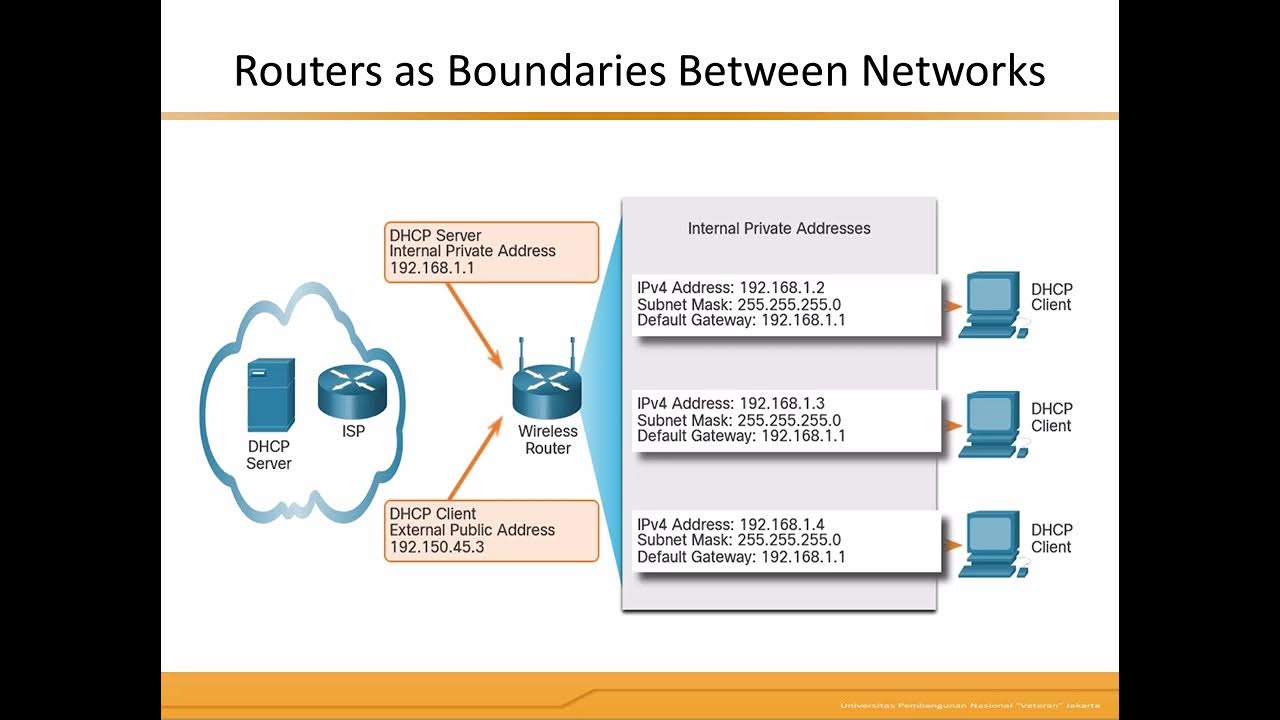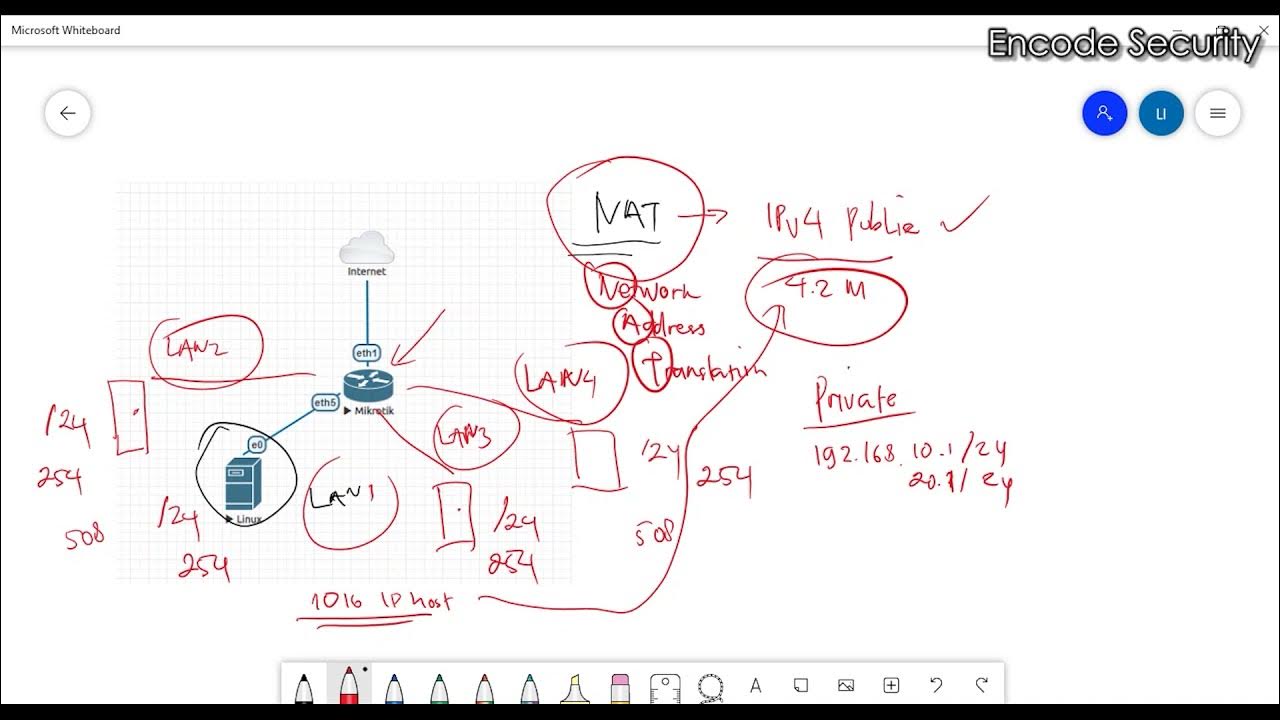NAT and Firewall Explained
Summary
TLDRIn this video, Frank Chodacki from the IBM Cloud team explains key network concepts, specifically Network Address Translation (NAT) and firewalls. Using an apartment analogy, he illustrates how NAT enables private network addresses to be translated into public ones, ensuring privacy and security. Frank also covers different types of firewalls, from basic 'stateless' ones to more advanced 'stateful' and 'application' firewalls, explaining how each provides varying levels of security by monitoring network traffic and ensuring safe communication between networks.
Takeaways
- 😀 NAT (Network Address Translation) translates internet addresses to private address space, helping to manage the finite number of public IP addresses.
- 😀 Private IP addresses are used within internal networks, while public IP addresses are unique and addressable globally, like street addresses for apartments.
- 😀 NAT functions by converting an internal IP address into a public one, allowing communication between private networks and the internet.
- 😀 A NAT device keeps track of outgoing traffic and the corresponding incoming response, ensuring correct delivery of the data.
- 😀 The NAT device helps obscure the internal address, offering a layer of security by protecting the identity of the internal user.
- 😀 A firewall works alongside NAT to monitor and filter network traffic, serving as a security device between internal and external networks.
- 😀 Stateless firewalls are like a simple lock on the door, allowing anyone with the right key to enter but vulnerable to tailgating or unauthorized entry.
- 😀 Stateful firewalls go a step further by monitoring the conversation between the source and destination of traffic, providing more security.
- 😀 Application firewalls analyze traffic at a deeper level, ensuring the content is legitimate (e.g., web traffic) and not malicious.
- 😀 Analogies like the apartment buildings and locks on doors help explain the concepts of NAT, firewalls, and security in a relatable way.
Q & A
What is NAT (Network Address Translation)?
-NAT is a method used to translate private internal IP addresses to a public IP address for communication over the internet. This process allows multiple devices within a private network to share a single public IP address when accessing external resources.
Why is NAT necessary in networking?
-NAT is necessary because there are a limited number of public IP addresses available, which are expensive to obtain. By using NAT, multiple devices on an internal network can share a single public IP address, conserving the number of public addresses needed.
How does NAT work using the apartment analogy?
-In the apartment analogy, the internal IP addresses are compared to apartment numbers within a building, while the public IP address is like the street address. NAT translates the internal apartment address into the public street address for communication over the internet.
What role does the NAT device play in this process?
-The NAT device acts as a translator, converting the internal IP address of a device in the network to a public IP address. It also tracks the connection and ensures that any response from the external server is routed back to the correct internal device.
What is the function of a firewall in the network?
-A firewall is a security device that monitors and controls incoming and outgoing network traffic. It acts as a barrier between the internal network and external networks, preventing unauthorized access and attacks.
What is the difference between a stateless and a stateful firewall?
-A stateless firewall simply checks whether packets are allowed or not based on predefined rules, similar to a lock on a door. A stateful firewall, however, tracks the state of active connections, allowing it to make more intelligent decisions about whether traffic should be allowed.
How does a stateful firewall improve security compared to a stateless firewall?
-A stateful firewall improves security by monitoring the entire communication session, including the context and state of the traffic. It can identify whether incoming traffic corresponds to an existing connection, making it more effective at filtering malicious or unauthorized traffic.
What is an application firewall and how is it different from stateful firewalls?
-An application firewall goes beyond monitoring the source and destination of traffic. It examines the content of the traffic, ensuring it is legitimate for its type. For example, it checks if web traffic is truly HTTP traffic and not some other type of traffic attempting to exploit vulnerabilities.
Why is the use of an application firewall likened to a security guard questioning the purpose of a visitor?
-Just as a security guard would question a visitor about their purpose before granting access, an application firewall inspects the traffic more deeply to ensure that it is legitimate. For example, it can detect malicious traffic disguised as normal web requests.
How does NAT contribute to security in networking?
-NAT contributes to security by obscuring the internal IP addresses of devices in a private network. Since external servers only see the public IP address, they are unable to directly access or target individual internal devices, adding an extra layer of protection.
Outlines

Этот раздел доступен только подписчикам платных тарифов. Пожалуйста, перейдите на платный тариф для доступа.
Перейти на платный тарифMindmap

Этот раздел доступен только подписчикам платных тарифов. Пожалуйста, перейдите на платный тариф для доступа.
Перейти на платный тарифKeywords

Этот раздел доступен только подписчикам платных тарифов. Пожалуйста, перейдите на платный тариф для доступа.
Перейти на платный тарифHighlights

Этот раздел доступен только подписчикам платных тарифов. Пожалуйста, перейдите на платный тариф для доступа.
Перейти на платный тарифTranscripts

Этот раздел доступен только подписчикам платных тарифов. Пожалуйста, перейдите на платный тариф для доступа.
Перейти на платный тариф5.0 / 5 (0 votes)






